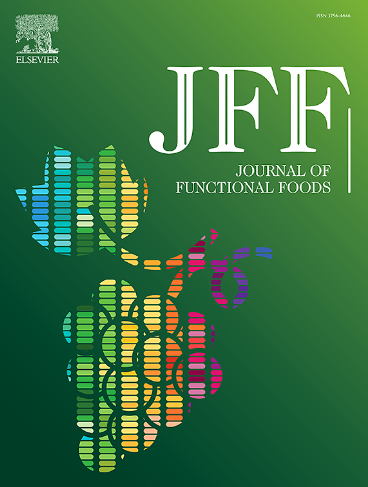系统性炎症生物标志物作为高血压患者饮食类黄酮与睡眠障碍之间关联的介质:一项基于人群的研究
IF 3.8
2区 农林科学
Q2 FOOD SCIENCE & TECHNOLOGY
引用次数: 0
摘要
饮食中的类黄酮有利于慢性疾病的治疗。本研究旨在探讨膳食类黄酮摄入对高血压患者睡眠障碍的影响,并探讨全身性炎症生物标志物的潜在介导作用。横断面研究分析了全国健康与营养调查两个调查周期(2007-2008年、2009-2010年)4538名非住院高血压睡眠障碍患者的数据。结果显示,橙皮素可减轻高血压患者的睡眠障碍(OR = 0.86, 95% CI = 0.76 ~ 0.97;p = 0.037)。此外,中介分析表明,炎症标志物介导了高血压患者饮食橙皮素摄入与睡眠障碍风险之间的重要关联:CRP (5.31%, P = 0.008)、PAR (12.29%, P = 0.016)和CAR (1.34%, P = 0.008)。摄取橙皮素有助于改善高血压患者的睡眠障碍,这种有利的关联部分是通过改善全身炎症标志物介导的。本文章由计算机程序翻译,如有差异,请以英文原文为准。

Systemic inflammatory biomarkers as mediators of the association between dietary flavonoids and sleep disorders in patients with hypertension: A population-based study
Dietary flavonoids are beneficial for the management of chronic diseases. This research aimed to investigate the impact of dietary flavonoid intake on sleep disorders in hypertensive patients and to explore the potential mediating effects of systemic inflammatory biomarkers. The cross-sectional study analyzed data from 4538 noninstitutionalized hypertensive patients with sleep disorders from two survey cycles (2007–2008, 2009–2010) of the National Health and Nutritional Examination Survey. The results showed that hesperetin alleviated sleep disorders in hypertensive patients (OR = 0.86, 95 % CI = 0.76 to 0.97; P = 0.037). Additionally, mediation analyses indicated that inflammatory markers mediated a significant portion of the association between dietary hesperetin intake and the risk of sleep disorders in hypertensive patients: CRP (5.31 %, P = 0.008), PAR (12.29 %, P = 0.016), and CAR (1.34 %, P = 0.008). Hesperetin intake positively contributed to improving sleep disorders in hypertensive patients, and this favorable association was partly mediated through improvements in systemic inflammatory markers.
求助全文
通过发布文献求助,成功后即可免费获取论文全文。
去求助
来源期刊

Journal of Functional Foods
FOOD SCIENCE & TECHNOLOGY-
CiteScore
9.60
自引率
1.80%
发文量
428
审稿时长
76 days
期刊介绍:
Journal of Functional Foods continues with the same aims and scope, editorial team, submission system and rigorous peer review. We give authors the possibility to publish their top-quality papers in a well-established leading journal in the food and nutrition fields. The Journal will keep its rigorous criteria to screen high impact research addressing relevant scientific topics and performed by sound methodologies.
The Journal of Functional Foods aims to bring together the results of fundamental and applied research into healthy foods and biologically active food ingredients.
The Journal is centered in the specific area at the boundaries among food technology, nutrition and health welcoming papers having a good interdisciplinary approach. The Journal will cover the fields of plant bioactives; dietary fibre, probiotics; functional lipids; bioactive peptides; vitamins, minerals and botanicals and other dietary supplements. Nutritional and technological aspects related to the development of functional foods and beverages are of core interest to the journal. Experimental works dealing with food digestion, bioavailability of food bioactives and on the mechanisms by which foods and their components are able to modulate physiological parameters connected with disease prevention are of particular interest as well as those dealing with personalized nutrition and nutritional needs in pathological subjects.
 求助内容:
求助内容: 应助结果提醒方式:
应助结果提醒方式:


